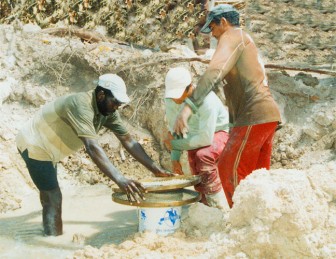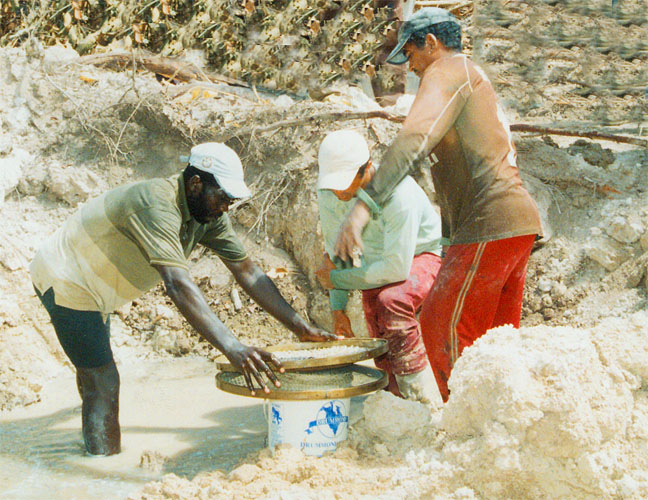On December 5 last year, Laurindo Robertson disappeared. He was found dead the next morning in a tunnel of the mining pit where he was working at Marudi in Region Nine.
He died from smoke inhalation, persons who worked with him claimed. His relatives said he was murdered. According to them, his body bore marks of violence on his back and head and there was blood where he was found. They said he had a problem with someone who worked with him. The police never investigated his death properly, they said. “Till up to this date, we are hearing nothing,” a relative said. Robertson was buried at Marudi. He left four children and a pregnant wife behind.
It is not clear how his death has been classified or whether it was even recorded by the authorities. But it added to the rising deaths in the mining industry as hundreds rush into the sector lured by high gold prices over the last couple of years. There has been an increase in deaths in the mining industry with the end of year report from the Labour Ministry saying that the sector saw 13 deaths last year accounting for over half of the industrial deaths nationally. More than half of those who died in industrial accidents nationally were between the ages of 15 and 35 years, particularly in the mining and forestry sectors.
It is “awful”, Prime Minister Samuel Hinds said. He said levels have to be raised both from the regulatory and miners sides. In a comment to this newspaper, Hinds, who is the minister responsible for mining, said that the Guyana Geology and Mines Commission (GGMC) and the Labour Ministry are working with miners. He pointed out that there are rules that govern how mining is done. “Of course it takes time to do it properly and people take shortcuts,” he said.
The Prime Minister said the GGMC has been raising awareness. “Maybe they have to start being a little bit more enforcing, and they would be a bit more enforcing,” he added.
 A campaign by the Ministry of Labour in relation to occupational health and safety in the mining and forestry sectors was due to start this month, Labour Minister Manzoor Nadir said when approached recently. He said they hope awareness will bring a reduction of incidents in the field. The campaign had been mentioned since last year.
A campaign by the Ministry of Labour in relation to occupational health and safety in the mining and forestry sectors was due to start this month, Labour Minister Manzoor Nadir said when approached recently. He said they hope awareness will bring a reduction of incidents in the field. The campaign had been mentioned since last year.
Executive Director of the Guyana Gold and Diamond Miners Association (GGDMA) Edward Shields said they are concerned about the number of deaths last year. “We believe that dredge-owners and claimholders should ensure that mining is done under conditions that would minimize accidents and of course death in the interior. One death is too much and we are willing to work with the Labour Department and the GGMC to improve in this department of occupational health and safety,” he said.
But he noted that often it is individual operators who take risks in terms of not following the correct procedures in mining. Shields explained that miners are not paid salaries but on a percentage basis so sometimes even thought they are warned not to go to a certain area “sometimes they will still go especially if is a hot hole [where gold is] because they want to make as much money as possible.” Miners might work for days and get nothing so they take risks, he said.
He also pointed out that there is a provision in mining regulations which says that a claimholder or the dredge owner is responsible for ensuring that operations are conducted safely and a miner could lose his claims for his inability to manage his operation. Shields said the mines officers need to monitor the mines and if they go below a certain depth, stop operations if necessary.
There are over 800 gold mining operations countrywide employing over 10,000 persons directly. There are over 1,000 dredges registered. Shields pointed out that a lot of mining is done in areas that have to be cleared. He said there are regulations that govern how mining should be done such as a pit cannot go past a specific depth without the permission of the GGMC and these are supposed to be monitored by mines officers. He said the GGMC would normally send in engineers who advise on how to proceed safely.
Acknowledging that there are a lot of accidents in the industry, Shields said he was aware that the Labour Ministry and the GGMC have signed a Memorandum of Understanding in relation to occupational health and safety. The Labour Ministry has contacted the association to discuss certain issues but to date, they have not met, he said. A scheduled appointment was postponed by the ministry until further notice, he said.
Apart from accidents, there are other dangers. Bandits have struck in the interior, sometimes taking lives in the process. “The security issue is a national issue,” the Prime Minster said.
Shields said this remains a concern for miners. One of the primary contributors to robberies is the fact that criminals are being harboured by illegal shops or Kayamoos, where narcotics are among the items sold, he added. He believes that if these illegal shops are removed, the criminals would be more easily identified.
But, he said, with a new commander for the interior, the police have been able to respond quickly to reports. Last year the police were able to arrest a lot of criminals because of the swift action, Shields said. He noted that there is now a better relationship in terms of miners giving information to the commander. Miners were afraid to give information to law enforcement agents stationed in the area for fear of victimization, he recalled.
He pointed out that there is a now a quick reaction squad and miners have been cooperating in terms of providing quick transportation. It’s a collaborative effort, Shields said.
But, he noted, there are still concerns with regard to the “roving patrols”. “There’s so many allegations that it does cause concern and I intend to bring it to the attention of the pertinent authorities and ask for an investigation of these numerous allegations to determine if it’s true or not true,” Shields said.





